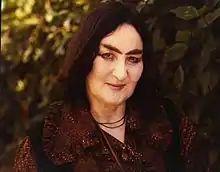 | |
| Born | March 12, 1922 Safad, Gaillee, British Palestine |
| Died | September 1, 1989 (aged 67) |
| Nationality | Israeli, Jewish |
| Known for | Painting |
| Movement | Israeli art |
Aviva Uri (Hebrew: אביבה אורי; March 12, 1922 – September 1, 1989) was an Israeli painter.[1]
Biography
Aviva Uri studied dance with Gertrude Kraus. In 1941, she married Moshe Levin, with whom she had a daughter, Rachel. In 1943, she studied painting with Moshe Castel, continuing with David Hendler in 1944. She married Hendler in 1963. She cultivated an unusual appearance, wearing white face makeup and dark eye-shadow, and oversized black clothing. She deliberately falsified her age, claiming she was born in 1927. She died in Tel Aviv in 1989.[2]
Artistic style
Uri's expressive drawings focused on line and composition. Her abstract drawings link her to the "New Horizons" group, but suggest an alternative to the abstract art being created in the country: instead of oils, she created drawings on paper; instead of the professional mixing of colors, she used no coloration; instead of Paris, she was influenced by Japan and China, or other individualists (Hans Hartung). Uri's free line influenced younger artists, such as Raffi Lavie.[3]
Awards and prizes
- Dizengoff Prize for Painting and Sculpture, Tel Aviv, 1953[1]
- Dizengoff Prize, Tel Aviv Museum, 1956
- Sandberg Prize for Israeli Art, Israel Museum, Jerusalem, 1976
- Prize of the Lea Porat Council of Culture and Art, 1985
- America-Israel Cultural Foundation, 1986
- Histadrut Prize, 1989
- Gutman Prize, 1989
See also
References
- 1 2 Uri, Aviva. "Chapters from the book about her life" (PDF). Aviva Uri. Archived from the original (PDF) on April 1, 2012. Retrieved November 9, 2011.
- ↑ Aviva Uri collection at the Israel Museum. Retrieved November 2011.
- ↑ Encyclopedia of Modern Jewish culture, (2005), Glenda Abramson
External links
- "Aviva Uri". Information Center for Israeli Art. Israel Museum. Retrieved 30 November 2011.
- Art of Aviva Uri at Europeana. Retrieved November 2011
- Aviva Uri Chapters from the book about her life in Hebrew
- Aviva Uri Silkscreens & Mixed media on paper Har-El Printers & Publishers 1977 1978